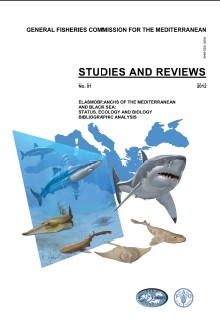FAO: Elasmobranchs of the Mediterranean and Black sea
FOOD AND AGRICULTURE ORGANIZATION OF THE UNITED NATIONS
ELASMOBRANCHS OF THE MEDITERRANEAN AND BLACK SEA:
STATUS, ECOLOGY AND BIOLOGY
BIBLIOGRAPHIC ANALYSIS
by
Mohamed Nejmeddine Bradai
Bechir Saidi
Samira Enajjar
Rome, 2012
ABSTRACT:
 The authors have compiled published information on taxonomy, distribution, status, statistics, fisheries, bycatch, biologic and ecologic parameters on age and growth, food and feeding habits, reproductive biology and stock assessment of elasmobranchs in the Mediterranean and Black Sea. This bibliographic analysis, through 661 papers dealing with elasmobranchs in the GFCM area, shows that cartilaginous species, including sharks, rays and chimaeras, are by far the most endangered group of marine fish in the Mediterranean Sea, with 31 species (40 percent of all) critically endangered, endangered or vulnerable. The biological characteristics of elasmobranchs (low fecundity, late maturity, slow growth) make them more vulnerable to fishing pressure than most teleost fish. Overfishing, wide use of non-selective fishing practices and habitat degradation are leading to dramatic declines of these species in the Mediterranean Sea. In general, elasmobranchs are not targeted but are caught incidentally. In many fisheries they are, however, often landed and marketed.
The authors have compiled published information on taxonomy, distribution, status, statistics, fisheries, bycatch, biologic and ecologic parameters on age and growth, food and feeding habits, reproductive biology and stock assessment of elasmobranchs in the Mediterranean and Black Sea. This bibliographic analysis, through 661 papers dealing with elasmobranchs in the GFCM area, shows that cartilaginous species, including sharks, rays and chimaeras, are by far the most endangered group of marine fish in the Mediterranean Sea, with 31 species (40 percent of all) critically endangered, endangered or vulnerable. The biological characteristics of elasmobranchs (low fecundity, late maturity, slow growth) make them more vulnerable to fishing pressure than most teleost fish. Overfishing, wide use of non-selective fishing practices and habitat degradation are leading to dramatic declines of these species in the Mediterranean Sea. In general, elasmobranchs are not targeted but are caught incidentally. In many fisheries they are, however, often landed and marketed.
The study also highlights the following points:
– Works are concentrated mainly in the western Mediterranean. Few works concern endangered
species and those of the GFCM priority list;
– Much systematic confusion persists for some species and some others are doubtful;
– The IUCN red list shows clearly the vulnerability of elasmobranchs and the lack of data;
– A decline in cartilaginous fish species landings has been observed while fishing effort has generally
increased;
– A standardization of methods and expression of results on the biology should be generalized in the
whole Mediterranean;
– Papers on biologic parameters concern few species primarily in the occidental and central
Mediterranean areas.
Therefore, recommendations to fill gaps in order to protect and manage elasmobranchs stocks are proposed in this document. In fact, better understanding of the composition of incidental and targeted catches of sharks by commercial fisheries and biological and ecological parameters are fundamentally important for the conservation of these populations. Moreover, problems encountered by elasmobranchs in the GFCM area are highlighted and conservation measures are suggested.
PDF – DOWNLOAD
